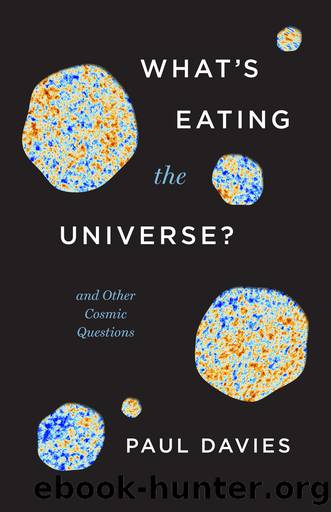What's Eating the Universe? by Paul Davies

Author:Paul Davies
Language: eng
Format: epub
Publisher: University of Chicago Press
Published: 2021-10-15T00:00:00+00:00
Figure 13. Headstone in Westminster Abbey commemorating Stephen Hawking, featuring his formula for the temperature of a black hole.
I put in some arduous work to get to the bottom of this discrepancy. The key to Hawkingâs result lies in the brief phase at the outset, when a ball of matter (e.g. a star) undergoes a convulsion and collapses to produce the black hole. The death of the star â abrupt, catastrophic, near-instantaneous â marks the birth of the black hole, but a subtle record of the starâs sudden demise lingers on, engraved into the quantum vacuum, disrupting it to produce a continuous flux of energy that lasts for as long as it takes for the black hole itself to die. And black holes take an unconscionable time a-dying: an object born in a microsecond might take a billion trillion trillion trillion trillion trillion years to evaporate away completely.
With the benefit of hindsight, all that was there in Hawkingâs lecture if I hadnât been too stupid to see it. What finally convinced me that Hawking was right was a simple calculation I made to describe an observer who accelerates through empty space, in the absence of any gravitational field. Because acceleration mimics a gravitational force, constant acceleration represents an analogue of a black hole, but with simpler mathematics. What I found was striking: an accelerating observer would perceive a bath of heat around herself, closely analogous to the Hawking radiation around a black hole. That result was confirmed the following year in an elegant calculation made by William Unruh, who showed that a particle detector accelerating through a quantum vacuum would indeed absorb energy as if immersed in heat radiation.
Hawkingâs lecture had an energizing effect on the physics community. Previously, only a handful of physicists were interested in quantum effects induced by gravitational fields, which were generally deemed to be too small to make much difference to anything, but it would quickly become one of the most intensively studied topics in theoretical physics. Itâs true that âthe Hawking effectâ, as the evaporation of black holes soon became known, is exceedingly weak. But the real significance of his result lay in its unexpected combination of simplicity and depth: the equation for the temperature of a black hole, like Diracâs formula for the electron, contained very few symbols but nevertheless opened a whole new window on reality. And, as with Dirac, Hawkingâs equation may be found in Westminster Abbey (see Figure 13).
Although nobody has ever detected radiation from a black hole, the conceptual ramifications of the prediction soon proved both vexing and profound. One immediate puzzle concerned the source of heat energy, which must ultimately come from the mass (= energy) of the black hole. Since nothing can get out of a black hole, the quanta of heat radiation have to be created outside the event horizon. But then how does their energy derive from the interior of the hole? It seemed paradoxical.
I set to work on this problem with colleagues William Unruh and Stephen Fulling, and we soon figured out what was happening.
Download
This site does not store any files on its server. We only index and link to content provided by other sites. Please contact the content providers to delete copyright contents if any and email us, we'll remove relevant links or contents immediately.
Sapiens: A Brief History of Humankind by Yuval Noah Harari(13036)
Sapiens by Yuval Noah Harari(4528)
Homo Deus: A Brief History of Tomorrow by Yuval Noah Harari(4272)
Pale Blue Dot by Carl Sagan(3995)
Origin Story: A Big History of Everything by David Christian(3133)
Livewired by David Eagleman(3113)
Brief Answers to the Big Questions by Stephen Hawking(2872)
Inferior by Angela Saini(2829)
Origin Story by David Christian(2677)
The Evolution of Beauty by Richard O. Prum(2550)
Signature in the Cell: DNA and the Evidence for Intelligent Design by Stephen C. Meyer(2495)
The Gene: An Intimate History by Siddhartha Mukherjee(2487)
Aliens by Jim Al-Khalili(2376)
How The Mind Works by Steven Pinker(2206)
Sex at Dawn: The Prehistoric Origins of Modern Sexuality by Ryan Christopher(2148)
From Bacteria to Bach and Back by Daniel C. Dennett(2144)
A Short History of Nearly Everything by Bryson Bill(2131)
Endless Forms Most Beautiful by Sean B. Carroll(2079)
Who We Are and How We Got Here by David Reich(2056)
